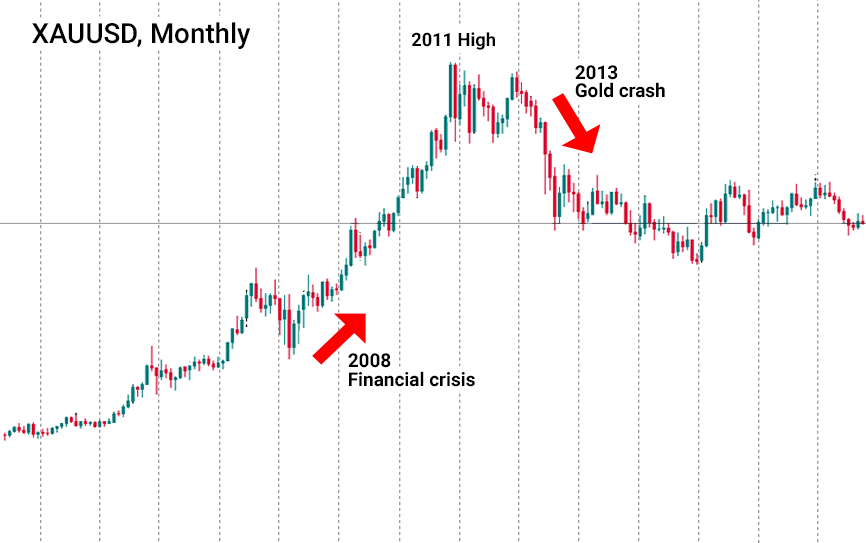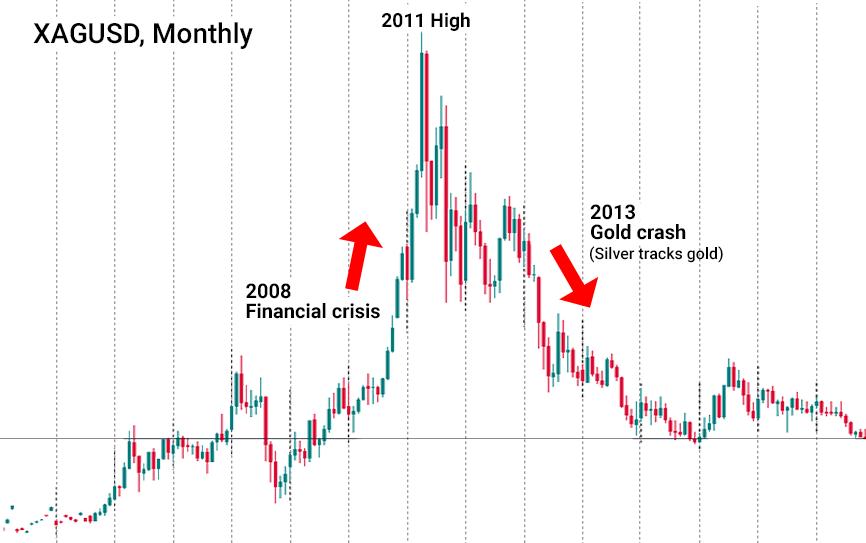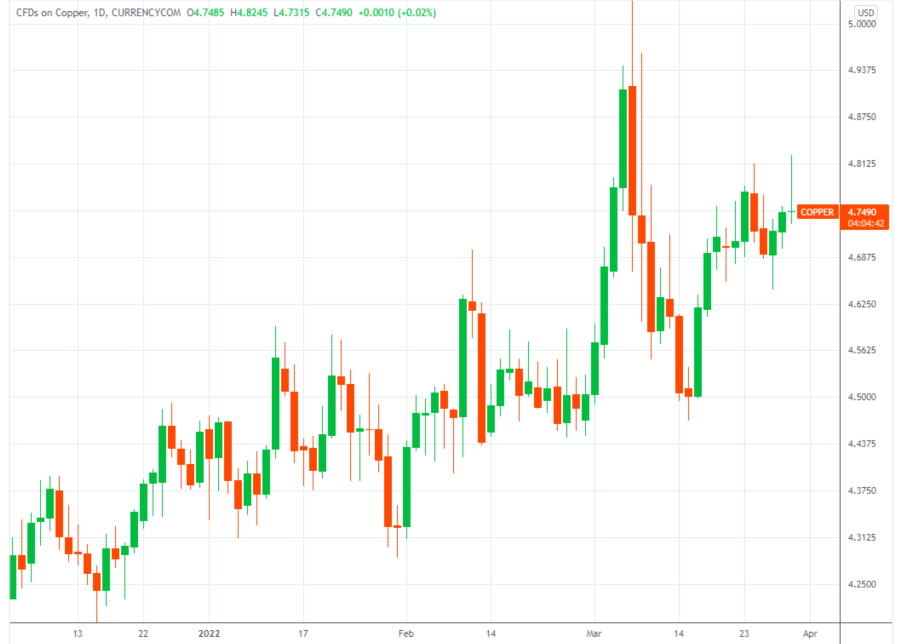Successful Investing in Precious Metals
Since ancient times precious metals, such as gold, platinum, and silver have been remaining the source of financial stability for the people, especially during times of uncertainty. Wars start and end, centuries change and the metals stay the best safe-haven assets to invest in. Why are they so recognizable among investors? Let’s find out.
Investment in Gold (XAU)
When you plan to make investments in gold, do not think that you will buy or sell a bullion itself. Instead, you will make operations with the spot price of a gold. It can be driven by the various factors and reflect the global changes across the markets. Let's find out why choosing gold is good for your investment strategy.
The “yellow metal” takes part in the financial markets for a long time. In the previous ages, it was even used to support fiat currencies. During the gold standard period, the paper money had to be backed up by an equal amount of gold in their reserves.

Since 1980-s until the early 2000s, the interest to this precious metal was very low due to the rising stocks and the strong and stable growth of economies. That is why the price was situated within a range between approximately $300 and $500 during that period of time. Interest for investing in gold grew after the financial crisis in 2008. The price even reached $1,907 in August of 2011. A recovering US economy as well as the Fed rate hikes since 2013 weakened the gold, however, the precious metal continues to attract the attention of investors.
So why do investors choose Gold?
- It is a safe haven asset that remains stable during uncertain times, including declines in the investment market, extremely high national debt, weak currency, high inflation, war, and social instability;
- The history of the gold standard makes the golden asset behave more like a currency than a commodity;
- The gold acts as a subject of speculation;
- Gold is universal: it is durable, portable, and widely accepted.
Factors that influence gold’s price
Unlike the key currencies, gold is not supported by the levels of employment, production, and infrastructure. It can be compared to the other assets like oil or corn as they all have physical characteristics. However, the price of a gold usually acts independently of its industrial supply and demand. Below we explained the most important drivers of gold's price.
- Central bank reserves. Central banks hold the yellow metal for diversification purposes. Gold also can be used to fund emergency liquidity or currency interventions. In addition, central banks pay attention to the economic conditions of a country when deciding to buy or sell gold. For instance, if a central bank decides to diversify its monetary reserves, the price for gold rises.
- Risk aversion. The sentiment in the equity market also plays an important role in the price of a yellow metal. If the risk-off dynamic increases, investors prefer to sell the stocks and turn to a safe and more stable gold.
- Central banks’ interest rates. This is a historical factor affecting the price of gold. When the real interest rates are set on a low level, investment alternatives can provide a low or negative return, pushing investors towards gold. If the interest rates are high, the investment attractiveness of a safe-haven asset decreases.
- The USD dynamics. As gold is priced in US dollars, there is a huge inverse correlation, that is, they move in different directions. If investors sell the greenback to the market, gold becomes more attractive and, as a result, more expensive. Alternatively, if the USD strengthens, gold prices tend to fall. However, you should know that it happens not in all cases, but mostly during the times of crisis and huge uncertainties in the economy.
- Consumer price index tends to correlate directly to changes in the price of gold. If the inflation is high, investors are looking for more "hard" and reliable assets and choose to invest in gold. Otherwise, if the conditions of the economy are good, the demand for gold is falling down and the asset becomes cheaper.
- The gold producing countries. Political uncertainties in the gold-producing countries, as well as the sanctions applied on them, can affect the levels of gold production and, therefore, increase its price. However, as there is no widely known official document which represents the level of production to investors, this factor is the least informative for investment purposes.
Investment in Silver (XAG)

Silver is the second popular metal among investors. As its yellow brother, it has been considered as a currency for a long time. For example, the British pound is called pound because it was equal to a pound of silver. Most of the factors affecting the price of the asset are similar to those which belong to gold, however, there is a slight difference in volatility. The price dynamics are similar, however, silver less volatile than gold.
Investment in Platinum (XPT)

Platinum is the rarest metal used for financial purposes. Its price is mostly affected by industrial demand and the mining process. As the production is concentrated in fewer countries, than the production of gold, the volatility in platinum is higher, than in any other metal market. Moreover, it tends to be more affected by the world uncertainties, than other metals.
Investment in Copper (XCP)
Copper is a soft red metal with a limited supply. People use it in piping, electrical wiring, car radiators, and other necessary things. Due to fast industrialization and electrification, the demand for copper has increased massively.
If you want to invest in copper, you can do it directly or indirectly. In the first case, you can buy bullion bars or copper coins and hold them as long as the price of copper is strengthening.
You can also invest in copper futures. An investor can either buy or sell a certain amount of copper on a specified expiration date.
In the case of indirect investment, you can buy stocks of copper-producing companies, such as BHP Group, Southern Copper, or Freeport-McMoRan. There are also copper ETFs that track the price of copper. They can hold copper bullion, copper futures, or stocks of copper miners. Other options for indirect investment in copper are copper mutual funds and options.
Like the price of any other commodity, the cost of copper is driven by supply and demand. It's also highly dependent on the economic activity in the world. There is a notable correlation between the Chinese GDP Growth and the price of copper since China accounts for the largest share by far of global demand for coil.
Another interesting correlation is between copper and oil prices. The copper price will rise following the uptrend in oil prices due to its energy consumption.
Below you can see the uptrend in copper futures since 2021.

Investment in Palladium (XPD)
Palladium is a metal that is similar to platinum. It's a necessary element for producing electronic products and catalytic converters for automobiles. It's also used for developing carbon monoxide detectors.
If you want to invest in palladium directly, you can buy it at its spot price or via a futures contract. You can also trade palladium as contracts for difference.
Among the primary factors driving the price of palladium are supply and demand. The situation in the car industry affects palladium's price as well since drivers have switched from diesel-run cars to petrol vehicles, which use palladium in their catalytic converters.
On the chart below, you can see the weekly performance of Palladium from November 2021.

To conclude with, investors choose metals as safe assets during the times of instability. They can bring a more stable profit and are less affected by the changes in markets.